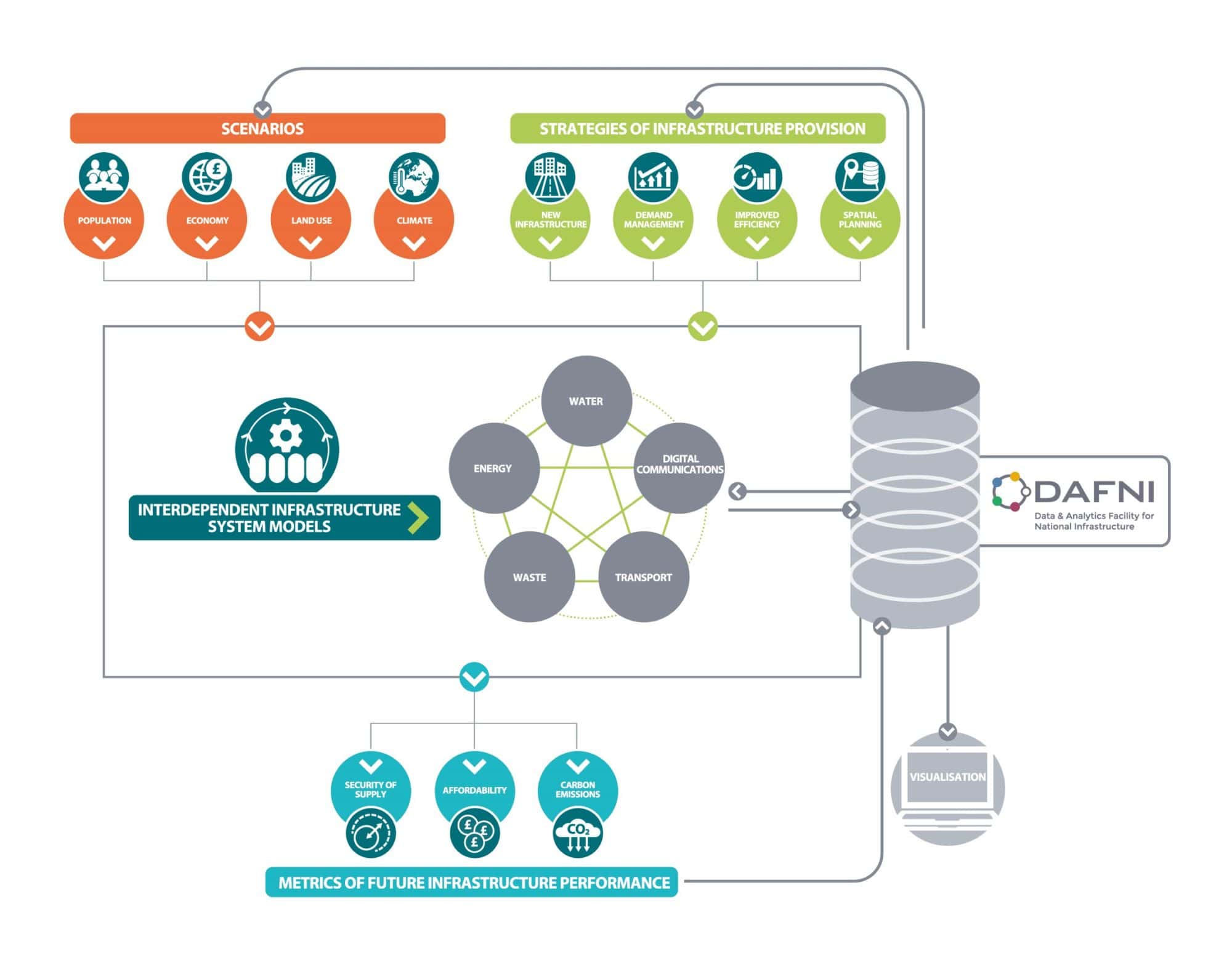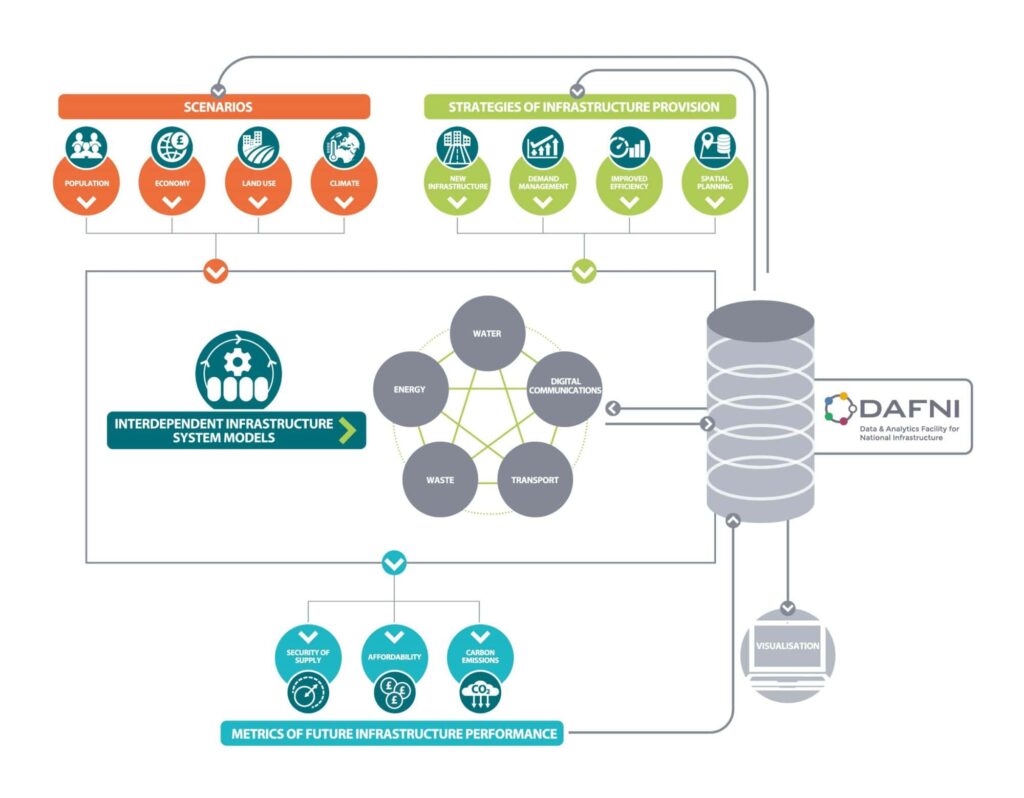ITRC’s NISMOD moves on to DAFNI’s next-generation computing platform, ushering in an exciting new phase of collaboration and development


On 21 January 2021 we held a webinar to celebrate the world-leading National Infrastructure Systems Model, (NISMOD) moving to its permanent home on the DAFNI (Data & Analytics for National Infrastructure) platform.
The world’s first national infrastructure system-of-systems model, NISMOD was created in the Infrastructure Transitions Research Consortium (ITRC) programme led by University of Oxford. NISMOD has been used to analyse long-term investment strategies as well as risk and vulnerability in infrastructure networks nationally and globally.
Professor Jim Hall of the University of Oxford and leader of the ITRC team, said, ‘“NISMOD is a world first. It integrates national systems analysis of energy, transport, water and digital communication systems, providing evidence for policymakers, planners and infrastructure operators.
“Not only does it simulate the performance of national infrastructure, it also contains hundreds of layers of national-scale data for systems analysis and visualisation. NISMOD is the product of ten years of research by seven of the UK’s leading universities, led by the University of Oxford. DAFNI will provide the permanent home for NISMOD – a lasting legacy that researchers can build upon and practitioners can use in a secure, reliable, high performance computing environment.”
He added, “Joining with DAFNI brings tremendous strengths. It brings compute power. It brings the convenience of containerisation. It provides access to modelling and a link into visualisation, and capability for coupling allows realisation of a notion of federated solutions to a whole range of different infrastructure questions.’
The event not only marked the beginning of this exciting joint venture but reviewed NISMOD and DAFNI’s pioneering achievements so far and looked to the future, inviting yet further stakeholders from academia, government and industry to come on board and benefit from this unique collaboration.
Dr Brian Matthews is DAFNI Group Leader, his presentation illustrated DAFNI’s hugely important role as a community hub: a high-performance computing platform, a secure repository for heterogenous national infrastructure data and models, a collaborative platform to research and develop multi-system models of infrastructure assets and systems, and a place to make data and models available for long-term accessibility, and as a legacy – to be maintained, developed and added to long-term.
Dr Matthews gave many examples of DAFNI’s take-up so far, including an exciting new initiative with the University of East Anglia in association with DEFRA called OpenCLIM (Open Climate Impact Framework) which aims to use a multi-systems approach to assess the risks of climate change and devise methods of mitigating them by adapting the environment – thus working towards CCRA4: the government’s Climate Change Risk Assessment 2026.
Tom Russell, an ITRC research software engineer based in the University of Oxford, took a deeper dive into some of the research done using NISMOD so far, ranging from regional work on the Oxford–Cambridge Arc to national modelling of water supply and towards net-zero transport options, as well as exploring different urban development scenarios with sustainability and the utility of green spaces in mind.
Hands-on demonstrations on how to use the platform to develop workflows and generate visualisations were given by Rose Dickinson from DAFNI and Martin Robinson from the University of Oxford.
Looking towards an exciting future, Dr Brian Matthews spoke of the DAFNI’s aspirations as it moves from a development phase (comprising requirements gathering, design and implementation) into a production phase, whilst building momentum for the long-term.
This transition is already well underway, with a user-base increase from a handful to a hundred in the last six months, thanks to the pilot and Champions programmes, outreach events – such as these webinars and hackathons – and momentum building with universities, commercial, central and local government.
The last words went to Professor Jim Hall: ‘”There is so much being talked about now, in terms of the need for data to support decision-making, data in government, the National Data Strategy and also the role of all sorts of different types of modelling. And, quite simply, DAFNI provides a solution. And as you’ll have seen today, it’s a solution that works.
“Today is a milestone. Getting NISMOD running on DAFNI has been one of the key things for the team to focus on, and now it’s there. I want to congratulate everyone involved. But this is only part of the journey, and the best is still ahead of us. So please stay with us and join us for what’s to come.”
Get in touch with Marion Samler, DAFNI partnership manager, to discuss collaborating with DAFNI or to start your user journey: marion.samler@stfc.ac.uk
Catherine Dhanjal is the director of The Answer.
Interested in collaborating with DAFNI?
If you would be interested in using DAFNI, would like to access Data on DAFNI or involve us in a new project, we would like to hear from you. Please complete your details on the contact form using the link and we will be in contact with you by email.
